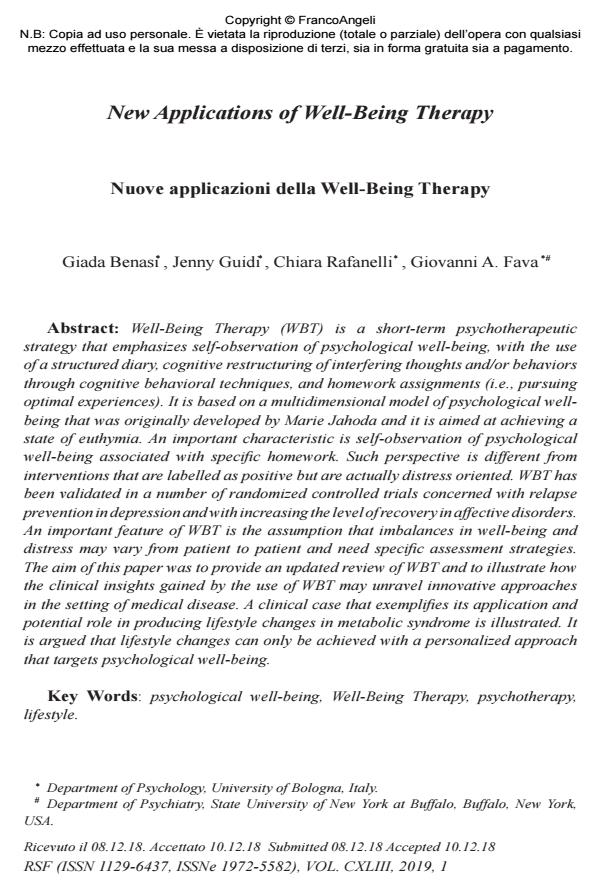New Applications of Well-Being Therapy
Journal title RIVISTA SPERIMENTALE DI FRENIATRIA
Author/s Giada Benasi, Jenny Guidi, Chiara Rafanelli, Giovanni A. Fava
Publishing Year 2019 Issue 2019/1
Language English Pages 20 P. 87-106 File size 1827 KB
DOI 10.3280/RSF2019-001006
DOI is like a bar code for intellectual property: to have more infomation
click here
Below, you can see the article first page
If you want to buy this article in PDF format, you can do it, following the instructions to buy download credits

FrancoAngeli is member of Publishers International Linking Association, Inc (PILA), a not-for-profit association which run the CrossRef service enabling links to and from online scholarly content.
Well-Being Therapy (WBT) is a short-term psychotherapeutic strategy that emphasizes self-observation of psychological well-being, with the use of a structured diary, cognitive restructuring of interfering thoughts and/or behaviors through cognitive behavioral techniques, and homework assignments (i.e., pursuing optimal experiences). It is based on a multidimensional model of psychological wellbeing that was originally developed by Marie Jahoda and it is aimed at achieving a state of euthymia. An important characteristic is self-observation of psychological well-being associated with specific homework. Such perspective is different from interventions that are labelled as positive but are actually distress oriented. WBT has been validated in a number of randomized controlled trials concerned with relapse prevention in depression and with increasing the level of recovery in affective disorders. An important feature of WBT is the assumption that imbalances in well-being and distress may vary from patient to patient and need specific assessment strategies. The aim of this paper was to provide an updated review of WBT and to illustrate how the clinical insights gained by the use of WBT may unravel innovative approaches in the setting of medical disease. A clinical case that exemplifies its application and potential role in producing lifestyle changes in metabolic syndrome is illustrated. It is argued that lifestyle changes can only be achieved with a personalized approach that targets psychological well-being.
Keywords: Psychological well-being, Well-Being Therapy, psychotherapy, lifestyle.
Giada Benasi, Jenny Guidi, Chiara Rafanelli, Giovanni A. Fava, New Applications of Well-Being Therapy in "RIVISTA SPERIMENTALE DI FRENIATRIA" 1/2019, pp 87-106, DOI: 10.3280/RSF2019-001006